Unit: AM/FM Stereo Receiver
Manufacturer: Marantz
Model: 2218
SN: N/A
One of my customers brought in another beautiful Marantz receiver for restoration. The unit is in great cosmetic condition and works pretty well but has some issues typical for 40-50 years old electronic equipment. Several original dial lamps burned out, both BALANCE and VOLUME pots are dirty, and most switches have oxidized contacts due to aging. So, it should be serviced to bring it back to the factory spec and extend its healthy life for another 40 years.
Marantz 2218 is a fairly rare model. It is a lower-power AM/FM stereo receiver from the classic 22XX silver face series. It was manufactured from 1978 to 1980. It produces 18 watts per channel into 8 ohms with no more than 0.08% total harmonic distortion. The optional walnut veneer cabinet for this model is WC-116.
Marantz 2218 is a service-friendly receiver because of very good access to each PCB.
Main Amplifier & Power Supply Board (P700)
The power supply and main amplifier circuits are assembled on one board (P700).
The power supply circuit has six aluminum electrolytic capacitors: C753 thru C758. All of them were replaced with low impedance Nichicon UPW/UPM caps.
Test results on original capacitors removed from the power supply circuit:
C753: rated capacitance – 330uF, measured – 349uF, ESR – 0.01Ω, deviation: +6%
C754: rated capacitance – 220uF, measured – 236uF, ESR – 0.01Ω, deviation: +7%
C755: rated capacitance – 100uF, measured – 110uF, ESR – 0.02Ω, deviation: +10%
C756: rated capacitance – 330uF, measured – 304uF, ESR – 0.01Ω, deviation: -8%
C757: rated capacitance – 220uF, measured – 185uF, ESR – 0.08Ω, deviation: -16%
C758: rated capacitance – 1000uF, measured – 1246uF, ESR – 0.01Ω, deviation: +25%
The main amplifier circuit has four low leakage e-caps (C701, C702, C705, C706) installed in the signal path and four aluminum electrolytic capacitors (C709, C710, C717, C718). The original low leakage e-caps were replaced with modern low leakage Nichicon UKL caps. And the remaining aluminum e-caps were replaced with low impedance and high-reliability Nichicon UPW/UPM caps.
Test results on original capacitors removed from the main amplifier circuit:
C701: rated capacitance – 10uF, measured – 10uF, ESR – 0.94Ω, deviation: 0%
C702: rated capacitance – 10uF, measured – 9uF, ESR – 1.23Ω, deviation: -10%
C705: rated capacitance – 47uF, measured – 48uF, ESR – 0.23Ω, deviation: +2%
C706: rated capacitance – 47uF, measured – 47uF, ESR – 0.21Ω, deviation: 0%
C709: rated capacitance – 47uF, measured – 53uF, ESR – 0.11Ω, deviation: +13%
C710: rated capacitance – 47uF, measured – 54uF, ESR – 0.11Ω, deviation: +15%
C717: rated capacitance – 100uF, measured – 90uF, ESR – 0.04Ω, deviation: -10%
C718: rated capacitance – 33uF, measured – 39uF, ESR – 0.23Ω, deviation: +18%
Two large filter capacitors (C751, C752) were tested in-circuit with Atlas ESR70 capacitance meter. Both e-caps are still in a factory spec with minimum deviation from the rated capacitance. And both have zero ESR. So, I didn't change them. In general, the filter capacitors rarely fail in vintage gears, and I usually don't replace them unless their ESR is high or per customer request.
In-circuit test on two filter capacitors - both are still in spec
C751: rated capacitance – 6800uF, measured – 6490uF, ESR – 0Ω, deviation: -5%
C752: rated capacitance – 6800uF, measured – 6455uF, ESR – 0Ω, deviation: -5%
The original trimming resistors (R717, R718) on this board were replaced with new Bourns potentiometers.
Main amplifier & power supply board - before and after
Phono Amplifier Board (P400)
The phono amplifier board has two solid tantalum capacitors (C401, C402) installed in the input signal path, two low leakage electrolytic capacitors (C415, C416) installed in the output signal path, two filtering aluminum e-caps (C413, C417), and two DC blocking aluminum e-caps (C405, C406). Both tantalum capacitors were replaced with modern low leakage Nichicon UKL caps. The original low leakage e-caps as well as aluminum e-cap C413 were replaced with film polyester WIMA MKS2 caps. And the remaining aluminum e-caps were replaced with low impedance Nichicon UPW/UPM caps.
Test results on original capacitors removed from the phono amplifier board:
C401: rated capacitance – 3.3uF, measured – 3.5uF, ESR – 2.2Ω, deviation: +6%
C402: rated capacitance – 3.3uF, measured – 3.6uF, ESR – 2.5Ω, deviation: +9%
C405: rated capacitance – 100uF, measured – 137uF, ESR – 0.22Ω, deviation: +37%
C406: rated capacitance – 100uF, measured – 134uF, ESR – 0.21Ω, deviation: +34%
C413: rated capacitance – 1uF, measured – 1.3uF, ESR – 1.1Ω, deviation: +30%
C415: rated capacitance – 1uF, measured – 1uF, ESR – 4.1Ω, deviation: 0%
C416: rated capacitance – 1uF, measured – 1uF, ESR – 4.4Ω, deviation: 0%
C417: rated capacitance – 100uF, measured – 111uF, ESR – 0.01Ω, deviation: +11%
Phono amplifier board - before and after
Pre & Tone Amplifier Board (PE01)
The pre & tone amplifier board can be easily released from the chassis for servicing. One should remove the faceplate and then unscrew three nuts from the BASS, TREBLE, and BALANCE potentiometers. And that's it! Just compare with what you need to do to release the same board from the chassis in Marantz 2238B. Indeed, it is a service-friendly design!
When it is released from the chassis, it is also very easy to clean and lubricate all three controls on this board. I cleaned and lubricated them with DeoxIT FaderLube 5% spray.
This board has six low leakage e-caps (CE03, CE04, CE11, CE12, CE13, CE14) installed in the signal path, two bi-polar e-caps (CE15, CE16) installed in the output signal path, and one filtering aluminum e-cap (CE20). Four low leakage e-caps (CE03, CE04, CE11, and CE12) were replaced with film polyester WIMA MKS2 caps. The other two low leakage e-caps (CE13 and CE14) were replaced with modern low leakage Nichicon UKL caps. The original bi-polar e-caps were replaced with new bi-polar Nichicon UES caps. And the remaining filtering e-cap was replaced with a low impedance Nichicon UPM cap.
Test results on original capacitors removed from the pre & tone amplifier board:
CE03: rated capacitance – 1uF, measured – 1uF, ESR – 2.8Ω, deviation: 0%
CE04: rated capacitance – 1uF, measured – 1uF, ESR – 2.2Ω, deviation: 0%
CE11: rated capacitance – 1uF, measured – 1uF, ESR – 3.2Ω, deviation: 0%
CE12: rated capacitance – 1uF, measured – 1uF, ESR – 3.2Ω, deviation: 0%
CE13: rated capacitance – 4.7uF, measured – 4.8uF, ESR – 1.75Ω, deviation: +2%
CE14: rated capacitance – 4.7uF, measured – 5.1uF, ESR – 1.22Ω, deviation: +9%
CE15: rated capacitance – 4.7uF, measured – 5.1uF, ESR – 0.96Ω, deviation: +9%
CE16: rated capacitance – 4.7uF, measured – 5.2uF, ESR – 1.18Ω, deviation: +11%
CE20: rated capacitance – 100uF, measured – 111uF, ESR – 0.02Ω, deviation: +11%
Original and new bi-polar capacitors CE15 and CE16
Pre & tone amplifier board - before and after
Dial and Meter Lamps
The easiest way to replace the dial lamps in Marantz 2218 is to disassemble the PCB holding these lamps from the plastic holder. However, any attempts to do it will certainly result in breaking the small plastic tabs. The plastic holder becomes very brittle over time. Therefore, I always prefer to replace the old incandescent lamps from the front panel. It is also quite challenging to do because the dial scale should be removed from the chassis. The dial scale is mounted on the chassis with double-sided tape. And, it is always a risk to damage it. However, the risk is minimal if the right tools are used. And of course, some experience is also needed. I usually use an X-ACTO #2 Knife for this job and work very slowly with patience. The old incandescent lamps were replaced with warm white LED lamps to maintain the original look and decrease heat. Note, that there is no vellum paper behind the dial scale in Marantz 2218. It makes the replacement of dial lamps a little bit easier.
To replace the original incandescent lamp behind the meter in Marantz 2218, one should remove a small PCB holding the lamp. The small plastic tab will snap off for sure while trying to do it. But this is the only way to replace this lamp. Sad but true. However, I am always able to glue the small plastic tab back after the lamp is replaced. It takes some patience but is doable. I strongly recommend using a modern LED lamp (warm white or cool blue) here instead of a new incandescent lamp. The LED lamp not only substantially reduces the heat and thereby protects the vellum paper behind the meter but also will last almost forever. You wouldn't need to replace it again in the future and face the same trouble.
Dial scale removed - original incandescent dial lamps
Dial scale removed - warm white LED lamps
Bias Adjustment
The bias is measured across two emitter resistors (R731 and R733) on the left channel, and across two emitter resistors (R732 and R734) on the right channel. It should be adjusted to ~9mV with trimming resistors R719 and R720, respectively. It corresponds to the idling current of 20mA.
Bias on the left and right channels after restoration
Output Power Test
The final output power test was performed at the end of my restoration. The receiver was loaded with a low inductance 8Ω/100W dummy resistor for each channel. The oscilloscope was connected across the speaker terminals and a sine-wave signal of 1kHz was applied to the AUX jacks. The output sine-wave signal was perfectly symmetrical on both channels with no clipping up to 11.86 VRMS (left channel) and 12.21 VRMS (right channel). It corresponds to the output power of 17.6W on the left channel and 18.6W on the right channel. A very small difference (~6%) observed between the left and right channels can be attributed to the imperfection/aging of the balance potentiometer.
Output power test
As usual, all the knobs and the front panel were gently cleaned in warm water with dish soap. All controls have been cleaned with DeoxIT 5% contact cleaner and lubricated with DeoxIT FaderLube 5% spray.
The final result can be seen in the photos below. The receiver looks and sounds fantastic! Please watch a short demo video at the end of this post. Thank you for reading.
Marantz 2218 - after restoration

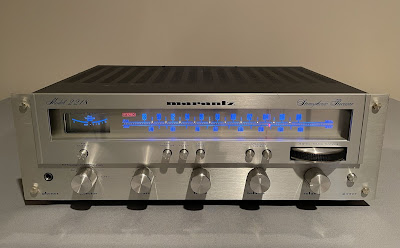
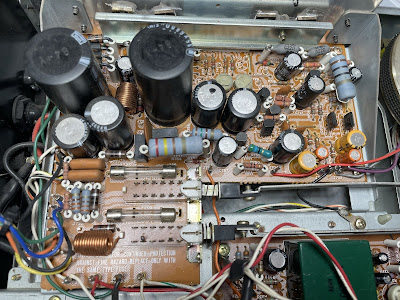
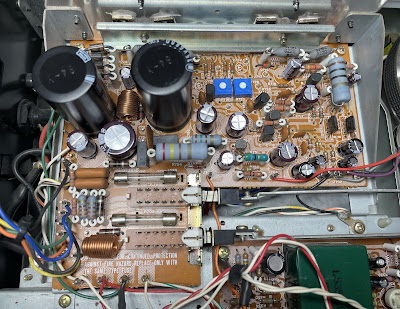


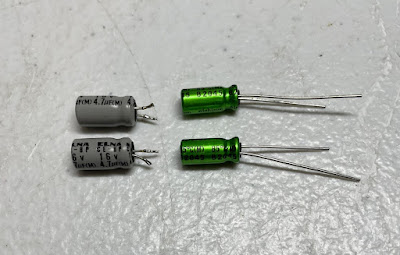



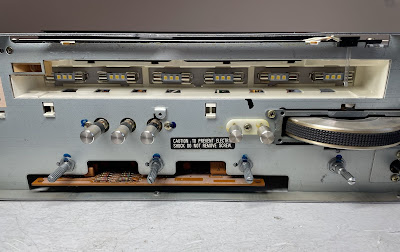
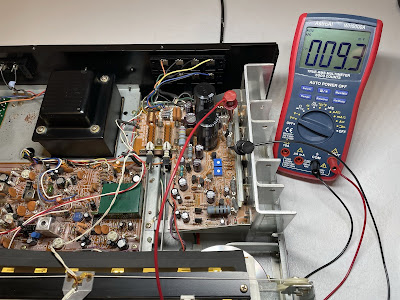
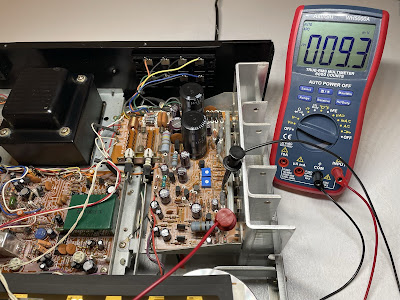



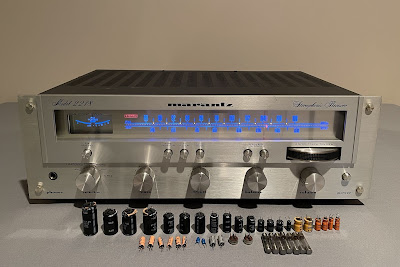
Another nice restoration, I'm in love with the Marantz units every since I heard one coupled with a pair of JBL 100s back in the day, awesome experience.
ReplyDeleteThank you! The JBL 100 are iconic speakers.
DeleteFantastic write up. I stumbled into a Marantz years ago when starting my audiophile journey. I will never part from the 2218. It's my baby. Going to use your archival to have mine serviced too. Thank you!
ReplyDeleteThank you for this level of detail on the 2218. My Marantz story begins back in 79'-80' with my 1st 22XX unit I don't know exactly which unit I owned then but believe it could be a 2218. This was my Jr. to Sr. year of HS and the unit , Marantz turntable & speakers stayed with me into my 1st marriage. Unfortunately 98' the marriage ended and the equipment stayed with my children's mother.
ReplyDeleteLast week one of my close audiophile friends was encouraging me to
relive my youth and look at a few Marantz 22XX's over at a local rebuilder. I stopped and looked at a few "rough" over priced $$ units.
Later that evening I thought I would look on "OfferUp" and search with a keyword "Marantz" and there popped up a 2218 that had been on for (6) months and priced down (3) months ago. I asked if the owner was the original he responded he was the second owner and had the unit over (10) years. We exchanged a few notes and his account didn't appear to be a reseller. Yesterday afternoon I went to look at the unit and it was owned by someone who cared. I listened to the (40+) year old machine connected to some small Polk speakers and made my offer in which he accepted hoping it was going to a new home that would enjoy it.
The funny part of this story is when I was inquiring looking for a photo from my ex-wife last week to see if we had one I could figure out my exact 22XX model she instantly responded I have some of your old albums I found + the old Marantz turntable still and not the tuner | receiver units. To be continued ..
with bright "LEDs"
The Marantz 2218 is a beautiful little receiver and quite rare. I would keep it if it is in good cosmetic condition. Unfortunately, most entry-level models today can only be found in fairly poor cosmetic condition.
DeleteYes, I believe it's in great condition by appearance but I'm sure the components should be updated like you describe here. Cosmetics I believe are very good I pulled the cover last evening after getting it home and fired up my vintage Rainbow vacuum and with a light brush & touch it cleaned right up. I pulled the front plated and also keep everything light while vacuuming. The tuning indicator lamp is out and the second owner told me he replaced (2) of the original bulbs when he got the unit. I haven't attached to speakers at my home I don't have any for it yet but plugged in my original Pioneer SE205 headphones I bought when I was (15) in 79' and they sounded fine but I need a decent antenna.
Delete